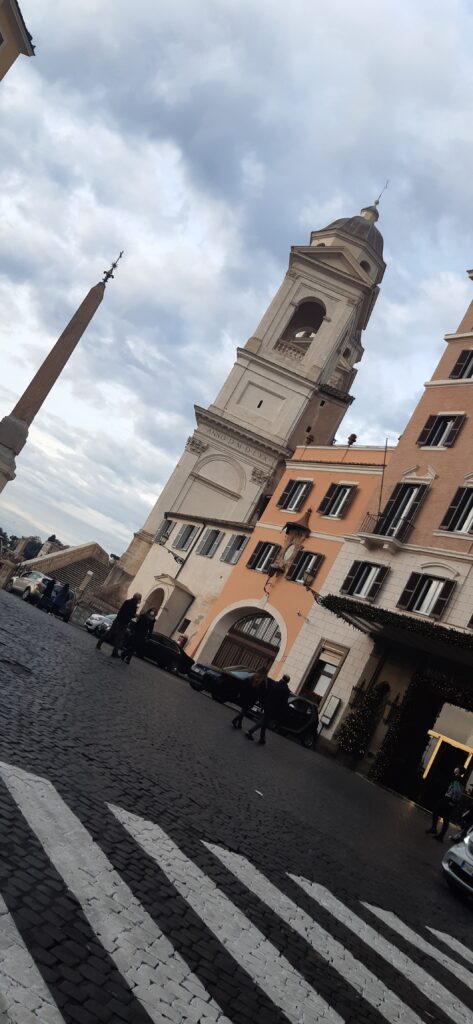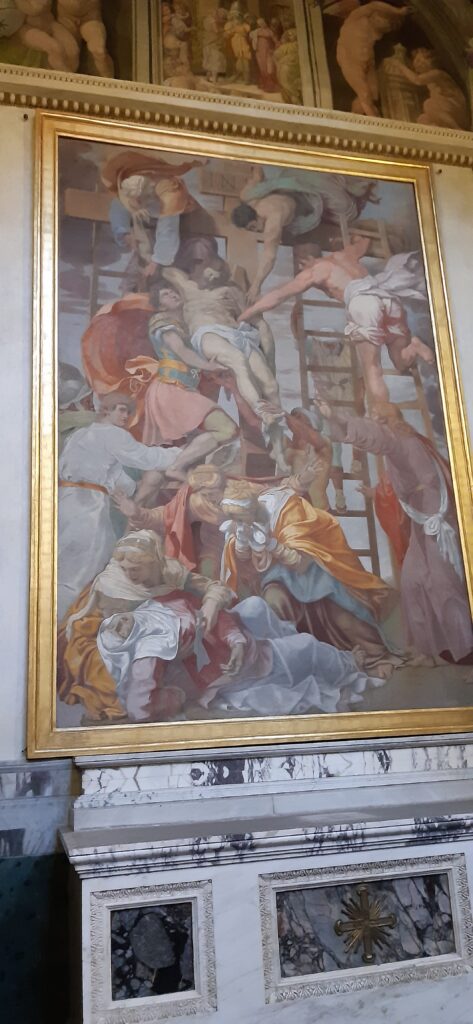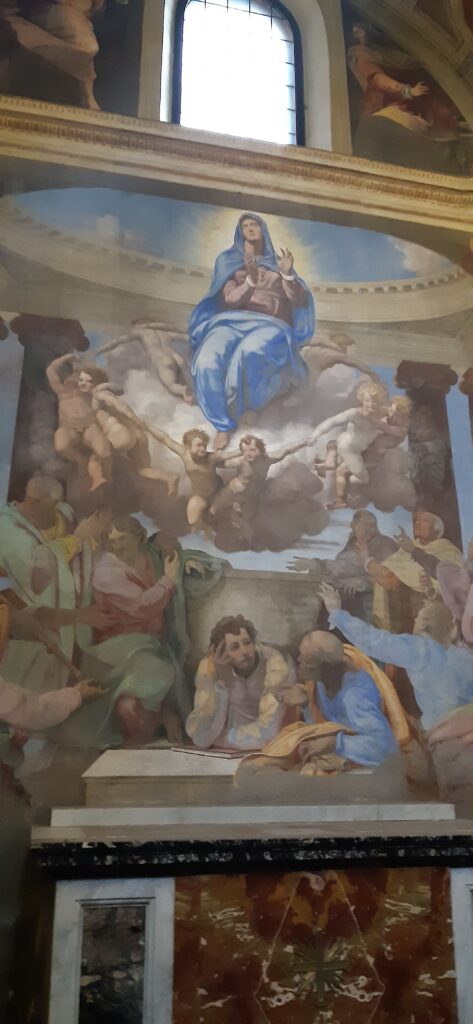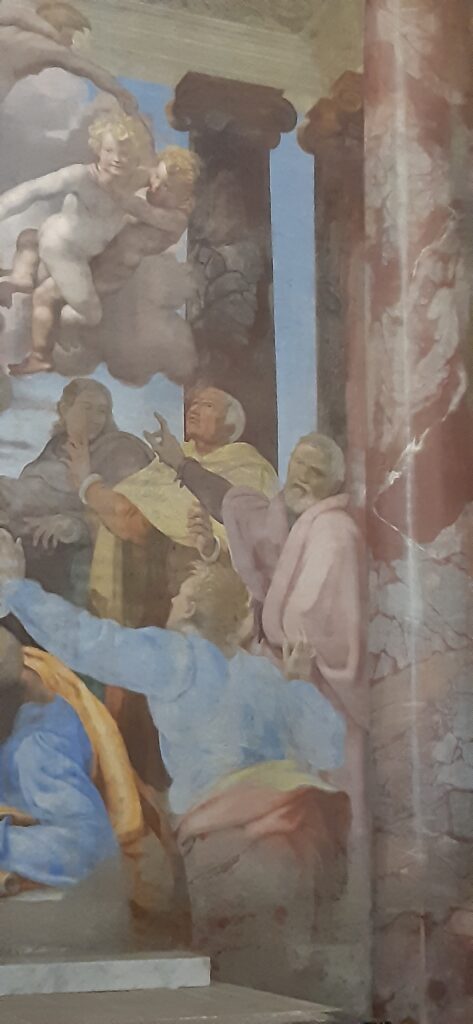Daniele da Volterra in the wake of Michelangelo
Italian version below*
There are artists who, despite their potential, have always lived in the shadow of a great master.
This is the case of Daniele da Volterra (born Daniele Ricciarelli), a friend even before a “pupil” of Michelangelo.
Too little is always known about his figure and most of the time he is simply known in spite of himself, as the Braghettone, or as the artist who covered with his “breeches” the nudes of Michelangelo’s Last Judgment in the Sistine Chapel.
Walking, however, in the center of Rome, we can enter a church, located in a breathtaking place, it is the Church of the Trinità Dei Monti (on the top of Piazza di Spagna, so to speak).

Inside, two chapels show us what Daniele da Volterra was capable of, with an unmistakable reference to Michelangelo.
In the year of the unveiling of the Last Judgment (1541), Elena Orsini, entrusted Daniele with the task of frescoing her noble chapel, with a cycle depicting the stories of Saint Helena (lost) and an altarpiece with the Deposition of Christ, still visible today, considered among the masterpieces of mannerism, copied by many artists in the following years.

The figures of the many characters present in the Deposition appear modeled with almost geometric and sculptural rigor which inevitably reveal the study of what Michelangelo did.
The choice of the asymmetrical cut, the cross is not in the center, gives great prominence to the gestures of the characters hoisted on the stairs and in the act of reaching out their arms towards the fulcrum of the representation.
Between 1548-1553, Daniele also realizes in Trinità dei Monti, with the help of aids, the decoration of the Cappella della Rovere (right aisle), with an evocative Assumption of the Virgin in which you can see a portrait of Michelangelo in the of an apostle pointing to the Virgin, and laterally the scenes of the Massacre of the Innocents and the Presentation of Mary in the Temple.

When Michelangelo fell ill in 1564, Daniele was next to him, and the day following the death of the great master Daniele was with Tommaso de Cavalieri drawing up the inventory of the objects present in the residence in Via Macel de Corvi in Rome.

To Daniele, Michelangelo’s nephew gave the task of drawing a portrait of the famous master from the funeral mask.
“… I find myself so troubled to be deprived of so much advice and sweetness at the same time.
Of course I thought I must grieve the death of such a master and father very much, but never so much, as he does … “(Vasari, Le Vite)
All rights reserved*
Follow me on FB/IG: selenia_eyeonart
Ci sono artisti che, nonostante il loro potenziale, hanno vissuto sempre nell’ombra di un grande maestro.
E’ il caso di Daniele da Volterra (nato Daniele Ricciarelli), amico prima ancor che “allievo” di Michelangelo.
Si conosce sempre troppo poco della sua figura ed il più delle volte è semplicemente noto, suo malgrado, come il Braghettone, ovvero come l’artista che ricoprì con le “braghe” i nudi del Giudizio Universale di Michelangelo in Cappella Sistina.
Camminando, però, in pieno centro a Roma possiamo entrare in una chiesa, situata in un luogo mozzafiato, è la Chiesa della Trinità dei Monti (sulla sommità di Piazza di Spagna, per intenderci).

Al suo interno, due cappelle ci mostrano ciò di cui è stato capace Daniele da Volterra, con un inconfondibile richiamo a Michelangelo.
Nell’anno dello scoprimento del Giudizio Universale (1541), Elena Orsini affida a Daniele l’incarico di affrescare la sua cappella gentilizia.
La richiesta era di un ciclo raffigurante le storie di Sant’Elena (andato perduto) e di una pala con la Deposizione di Cristo dalla Croce, tutt’ora visibile, considerata tra i capolavori del manierismo e copiata da tantissimi artisti negli anni a seguire.

Le figure dei tanti personaggi presenti nella Deposizione appaiono modellate con rigore quasi geometrizzante e scultoreo che rivelano inevitabilmente lo studio di quanto fatto da Michelangelo.
La scelta del taglio asimmetrico, la croce non è al centro, conferisce grande risalto alla gestualità dei personaggi issati sulle scale e in atto di protendere le braccia verso il fulcro della rappresentazione.
Tra il 1548-1553, Daniele realizza sempre in Trinità dei Monti, con l’intervento di aiuti, la decorazione della Cappella della Rovere (navata destra).
Al suo interno una suggestiva Assunzione della Vergine in cui si nota nella parte inferiore, un ritratto di Michelangelo nelle vesti di un apostolo che indica la Vergine e lateralmente le scene della Strage degli innocenti e la Presentazione al Tempio di Maria.

Quando nel 1564 Michelangelo si ammalò, Daniele gli era accanto.
Il giorno seguente la morte del grande maestro Daniele era con Tommaso de Cavalieri alla stesura dell’inventario degli oggetti presenti nella dimora di via Macel de Corvi a Roma.

A Daniele il nipote di Michelangelo diede l’incarico di trarre dalla maschera funebre un ritratto del celebre maestro.
“…mi trovo sì tribulato per esser privo di tanto consiglio e dolceza insieme. Certo ch’io giudicavo dovermi dolere molto la morte d’un tanto padrone e padre, ma non mai tanto, come fa…” (Vasari)
Sostieni la #culturachevince, aiuta la condivisione.
Segui le mie pagine Facebook/Instagram: selenia_eyeonart
Tutti i diritti sono riservati. E’ vietata qualsiasi utilizzazione, totale o parziale, dei contenuti inseriti nel presente portale, ivi inclusa la memorizzazione, riproduzione, rielaborazione, diffusione o distribuzione dei contenuti stessi mediante qualunque piattaforma tecnologica, supporto o rete telematica, senza previa autorizzazione scritta di Selenia Morgillo.